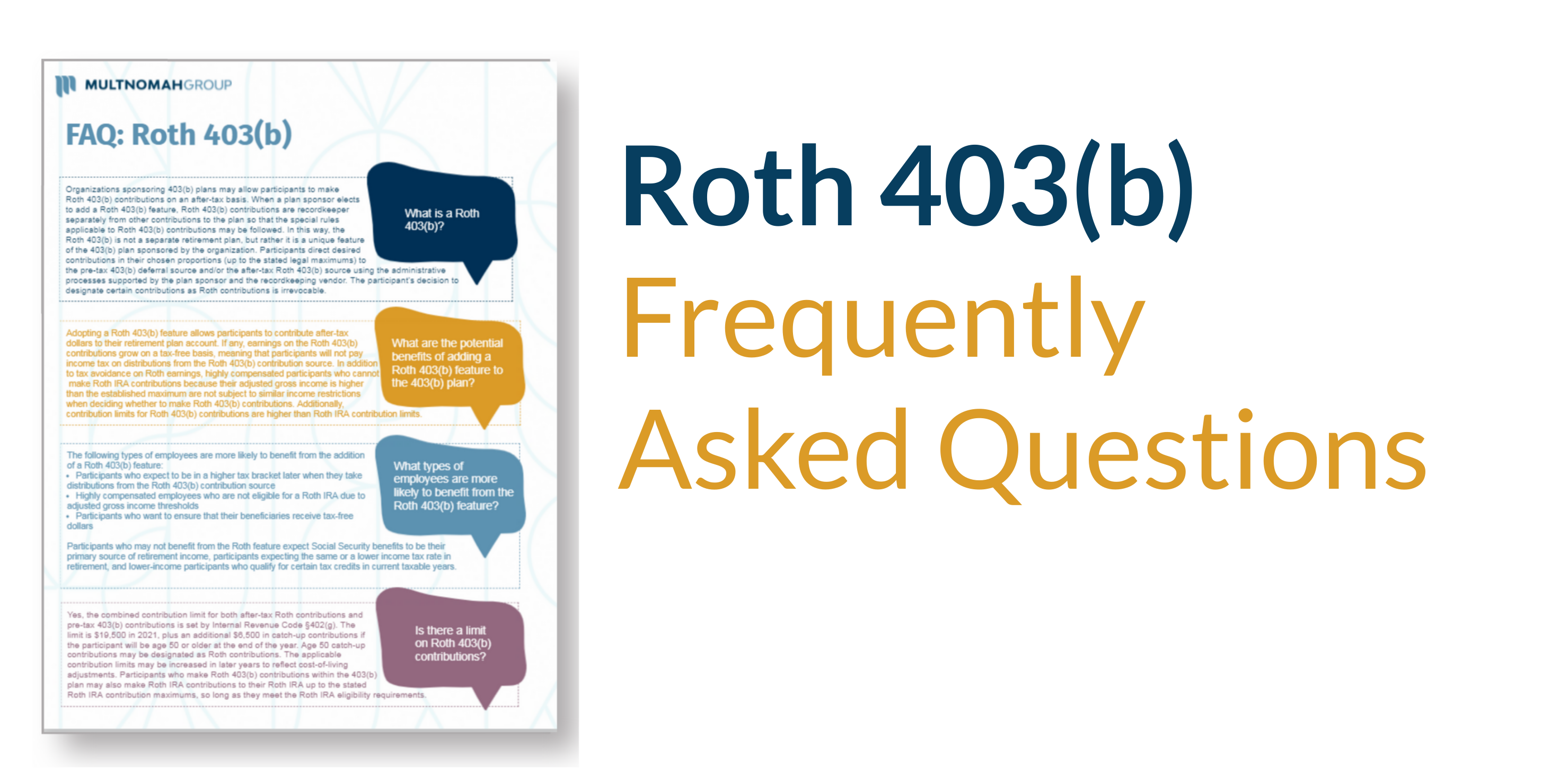Organizations sponsoring 403(b) plans may allow participants to make Roth 403(b) contributions on an after-tax basis. When a plan sponsor elects to add a Roth 403(b) feature, Roth 403(b) contributions are recordkeeper separately from other contributions to the plan so that the special rules applicable to Roth 403(b) contributions may be followed. In this way, the Roth 403(b) is not a separate retirement plan, but rather it is a unique feature of the 403(b) plan sponsored by the organization. Participants direct desired contributions in their chosen proportions (up to the stated legal maximums) to the pre-tax 403(b) deferral source and/or the after-tax Roth 403(b) source using the administrative processes supported by the plan sponsor and the recordkeeping vendor. The participant’s decision to designate certain contributions as Roth contributions is irrevocable.
Adopting a Roth 403(b) feature allows participants to contribute after-tax dollars to their retirement plan account. If any, earnings on the Roth 403(b) contributions grow on a tax-free basis, meaning that participants will not pay income tax on distributions from the Roth 403(b) contribution source. In addition to the avoidance of tax on Roth earnings, highly compensated participants who cannot make Roth IRA contributions because their adjusted gross income is higher than the established maximum are not subject to similar income restrictions when deciding whether to make Roth 403(b) contributions. Additionally, contribution limits for Roth 403(b) contributions are higher than Roth IRA contribution limits.
The following types of employees are more likely to benefit from the addition of a Roth 403(b) feature:
Participants who may not benefit from the Roth feature expect Social Security benefits to be their primary source of retirement income, participants expecting the same or a lower income tax rate in retirement, and lower income participants who qualify for certain tax credits in current taxable years.
Yes, the combined contribution limit for both after-tax Roth contributions and pre-tax 403(b) contributions is set by Internal Revenue Code §402(g). The limit is $19,500 in 2021, plus an additional $6,500 in catch-up contributions if the participant will be age 50 or older at the end of the year. Age 50 catch-up contributions may be designated as Roth contributions. The applicable contribution limits may be increased in later years to reflect cost-of-living adjustments. Participants who make Roth 403(b) contributions within the 403(b) plan may also make Roth IRA contributions to their Roth IRA up to the stated Roth IRA contribution maximums, so long as they meet the Roth IRA eligibility requirements.
Yes, the following special rules apply to Roth 403(b) contributions:
Once a participant is eligible for a distribution from the Roth 403(b) contribution source, Roth 403(b) accounts may be rolled directly into other designated Roth accounts, including those established in a Roth 401(k), a Roth 403(b), a Roth 457(b) or a Roth IRA. Rollovers of Roth accounts may have an impact on the 5-year holding period described above. Indirect rollovers of Roth 403(b) contributions are problematic and should be avoided.
An in-plan Roth rollover is a distribution from a participant’s non-Roth contribution sources that are rolled over to the Roth contribution source within the same plan at the participant’s direction. After weighing the administrative impacts and special rules associated with in-plan Roth rollovers, plan sponsors can decide whether or not to allow them.
Yes, plan sponsors may decide to permit participant loans from Roth 403(b) contribution sources. However, the plan sponsor’s administrative processes related to participant loans may be affected by a decision to allow loans from the after-tax Roth contributions. Plan loans are subject to certain legal requirements and the plan sponsor’s administrative policies.
Yes, a plan sponsor can elect to automatically enroll its employees in the 403(b) plan for purposes of pre-tax and after-tax Roth contributions. The automatic enrollment rules apply, and the plan must state how the employer will allocate automatic contributions between pre-tax contributions and Roth contributions.
The plan's design will determine whether the employer will make the stated employer contribution on Roth 403(b) contributions. Practically, there would be no reason for an employer not to match Roth contributions in the same manner that they match pre-tax contributions. If matching contributions are made by the employer on the participant’s Roth 403(b) contributions, the matching contributions are made on a pre-tax basis and earnings on the employer-made matching contributions are taxable at distribution.
A Roth 403(b) feature may be added to a 403(b) plan at any time by adopting a plan amendment prescribing the addition of the Roth 403(b) feature. A thoughtful communications strategy will promote the feature to the participant population so that they understand and feel comfortable using it. Additionally, the payroll file transmitting contribution and other data each payroll period may need to be updated to include a column for Roth 403(b) contributions. Each recordkeeping vendor will have administrative requirements for the establishment and operation of a Roth 403(b) feature.
The general requirements for adopting a Roth 403(b) feature are:
Additional requirements may apply depending upon the plan’s design and the vendor’s administrative processes.
Contact a consultant at Multnomah Group for more information on whether adopting a Roth feature would be advantageous for your plan.

To download a copy of our FAQ, please fill out the form to the right.

To download a PDF of our 403(b) FAQ, please fill out the form below.
© 2025 Copyright Multnomah Group Inc.